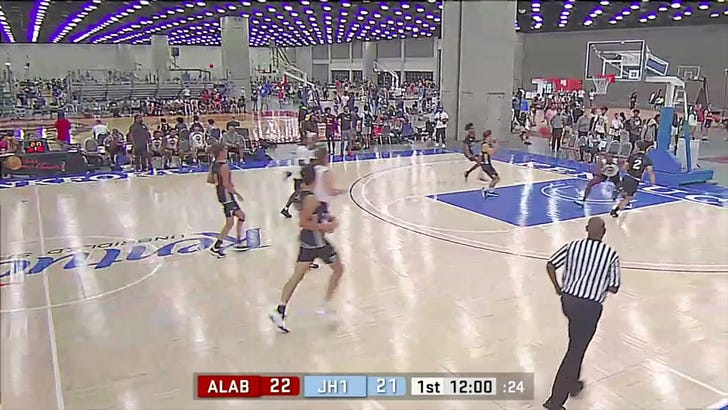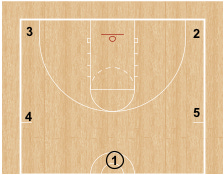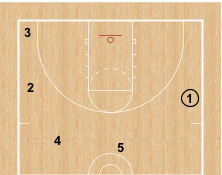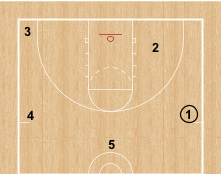Transition Offense
There probably aren’t too many coaches when asked how they want to play stylistically on offense during the upcoming season that will answer with, “We want to walk the ball up the floor, let the defense get set and then run a play that requires five passes.” Most coaches and programs talk about playing an uptempo style and giving players the freedom to shoot early in a possession.
Talking about tempo and having a general idea that you’d like your team to play and thrive in transition is a starting point. It’s much like establishing a goal- it gives basic clarity and direction, but after that it’s basically meaningless. Just like most teams have a goal of winning a championship in the pre-season, many teams also have a desire of playing uptempo in the pre-season as well. What ultimately will dictate how your team plays, however, is your system- the principles and habits emphasized daily. This article will go through the principles that we use to establish our transition offense.
Transition Concepts & Terminology
Possession First: Before we can transition to offense from defense, we obviously have to rebound the basketball and secure possession. Upon possession, we want the rebounder to scan quickly before automatically putting the basketball on the floor. Especially early in the teaching phase, many times the rebounder is quick to start racing up the floor with the basketball and ends up losing possession. Rebound, secure possession, and then we go. On a missed shot (this is dependent on personnel but we are usually very guard-heavy), we want that person to secure it and initiate our transition offense. We don’t need a set point guard coming back to the basketball. On a make, we generally will designate an inbounder and a point guard.
Sprint Wide & Deep: In order to thrive in transition, players have to be committed to sprinting the floor on a change of possession. We teach our players to race toward the sideline and the corner. If the corner is already filled by a player in front, then we fill the “stretch spot”, which is tight to the sideline TOK extended.
*Note*: If a player is behind the defense early, we encourage them to break their sprint toward the sideline and go to the rim. If they don’t receive the basketball, they filter out.
Pitch Ahead/ Across: If we can advance the basketball ahead with the pass that puts pressure on the defense, we want to do so. We consider a “pitch ahead” an advance pass that is on the same side. A “pitch across” is an advance pass that is on the opposite side of the floor.
Keep: If the rebounder secures possession and doesn’t have an advance pass or the advance pass gives us no gained advantage, the rebounder can “keep” and look to push the basketball and attack downhill into open space. When no immediate attack is available, that’s where our transition flow into the next action occurs (see below).
Right Back at Em’: This our phrase to encourage our players to attack on a made shot just as they would on a missed shot. As mentioned previously, we usually designate an inbounder who we like trailing the play and will also designate a point guard to receive the first inbound pass on a made shot by the opponent.
Transition Spacing/Alignment
Our base concepts in primary transition will give us space, but if we don’t have an early advantage, we want to arrive in an organized manner. We mostly operate from a 5-Out template, meaning to start most possessions we have no one inside the three-point line. Our most common alignments out of the 5-Out is a balanced floor with the corners and stretch filled on both sides and another player in the middle.
We generally like to have players bring the ball up the floor on a side, but if the corners and stretches are filled, players can bring the basketball up the middle of the floor, which obviously will open up opportunities to attack in the middle-third of the court.
Another alignment that we occasionally operate out of is an Empty 5-Out, which means the ball-side corner is empty.
If our strong-side corner posts we call it a “Power” alignment, where we have a strong-side post and an empty corner on that side.
It’s important that our players have the awareness to recognize these alignments as it helps connect them to actions that can be triggered within the flow of our offense.
Flow
Against good defensive teams, it’s likely they will try and take away immediate advantages in our primary transition by getting back and getting set. This is where our spacing (arriving organized) and ability to flow (continue to attack without stopping or resetting) becomes important. Many times we may not get a rim cut or an advance pass that leads to a quick shot, but by flowing directly into Space & Attack, we can still create an advantage and find a high value shot before the defense can get completely set.
We also have some quick actions that can be triggered from our common transition alignments to keep pressure on the defense early in the possession. Actions such as “Drag” (transition ball screen), “Center” (entry to trail & immediate weak-side screening action), and “Power” (strong-side corner post-up into a split action) are common automatics for us that don’t need a call.
Thank you for reading. If you have any questions please email me @ performancemaxllc@gmail.com.





